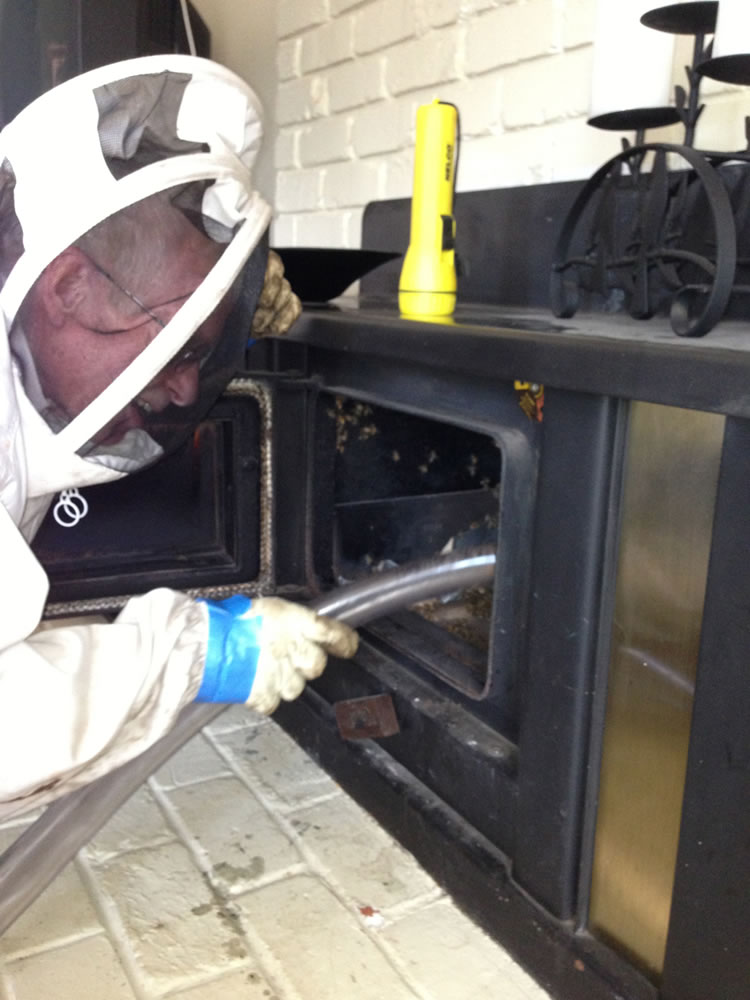Learn more on colony collapse disorder.
The group meets at 7 p.m. on the second Thursday of each month at the Center for Agricultural, Scientific and Environmental Education, 11104 N.E. 149th St., Brush Prairie. Group members routinely remove swarms from local properties at no cost. Call President Anton Check, 360-907-3264, for more information.
She opened the door to a stinging sight: a flurry of uninvited guests buzzing around her downstairs living room.
It’s difficult enough ushering an errant bee from your home. Now imagine tens of thousands.
That’s exactly what 70-year-old Anne Hargreaves faced last Friday when she glanced into her basement and discovered a huge swarm of honey bees. A few queens had apparently led their colonies into the chimney and invaded Hargreaves’ Washougal home through her Franklin stove.
“There were so many on the windows, it was even blocking the light,” she said. “I was stunned.”
A deep humming sound reverberated from the metal fireplace.
“It was the densest sound,” she said. “Very loud.”
The bee barrage might not have been on the level of a biblical plague, but it certainly put a bane on her weekend. It took four days for a volunteer from the Clark County Beekeepers Association to safely suck up the last of the buggers with his homemade vacuum contraption.
“I looked down that chimney, and I couldn’t believe it,” said Ron Prindle, the 63-year-old amateur beekeeper who answered Hargreaves’ plea for help. “That whole chimney was completely full of bees.”
Neither had any intention of harming the non-aggressive honey makers, especially considering bee populations have been dwindling in recent years (see more below).
“They were just trying to get out,” Hargreaves said. “They had a job to do out there. They were hungry.”
Prindle estimates he boxed about 10 pounds of bees, including at least four queens. The insects are now doing what they do best, producing honey at his small raspberry farm in Vancouver.
Through his affiliation with the local beekeepers group, Prindle goes on as many as 15 calls a year. In his three years as a volunteer, he said nothing has rivaled what he saw last weekend.
“That’s the most bees I’ve ever gotten, and I’ve hit some pretty big swarms,” he said.
Hargreaves, a retired human resources executive who has never been stung in her life, tried to be a hospitable host to her temporary roommates. As Prindle cleared out her chimney, she took a more discriminate approach, herding dormant bees into a jar with a paint brush so she could set them free outside.
“They were the most polite girls; I started calling them girls,” she said. “And I didn’t get one single sting.”
Bee colony collapse expanding
In the 1940s, there were about 5 million managed honeybee colonies. Now there are 2.5 million, even as agricultural demand for pollination services has increased.
While new pathogens and pests that arrived in the last few decades are partly to blame for dwindling bee populations, according to the U.S. Department of Agriculture, experts aren’t exactly sure what’s causing some honey bee colonies to disappear. Scientists are continuing to search for answers to the disconcerting “colony collapse disorder” phenomenon.
Washington State University entomology researchers announced June 6 they are developing a honey bee semen bank to breed a more resilient subspecies to help thwart the continuing colony collapse crisis in the United States.
Higher-than-expected bee losses in recent winters remain a significant threat to honey producers and farms that rely on pollination, especially the California almond industry, which uses about 60 percent of all maintained honey bee colonies in the country.
Stover Harger III: 360-735-4530; http://www.twitter.com/col_hoods; stover.harger@columbian.com
The group meets at 7 p.m. on the second Thursday of each month at the Center for Agricultural, Scientific and Environmental Education, 11104 N.E. 149th St., Brush Prairie. Group members routinely remove swarms from local properties at no cost. Call President Anton Check, 360-907-3264, for more information.



